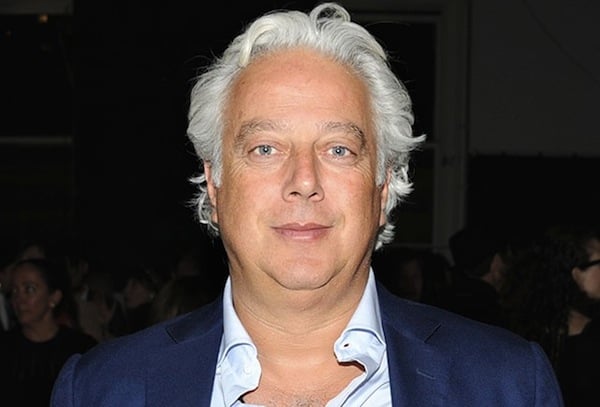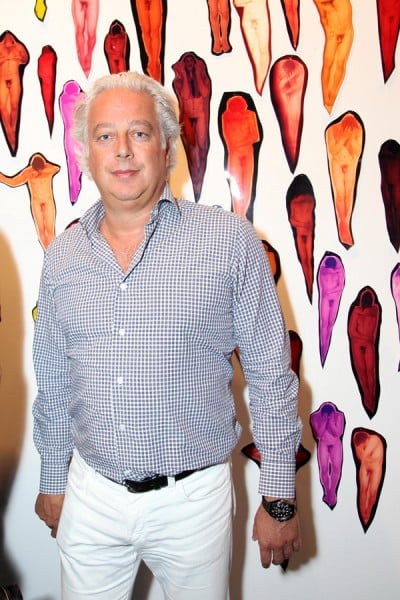People
What Is Collector Aby Rosen Doing as New York’s Arts Council Chairman?
Some think he's not behaving as an arts advocate should.

Some think he's not behaving as an arts advocate should.

Philip Boroff

Art collector Aby Rosen shared happy news at the New York State Council on the Arts (NYSCA) on October 16. Executive director Lisa Robb was now a grandmother. “Her daughter had a child,” Rosen, NYSCA’s volunteer chairman, announced at the agency’s Flatiron district office. “So we’re wishing her all good things in life.”
To be with her daughter and daughter’s newborn, Robb took a week off. She missed one of the council’s five public meetings last year and arguably the most important, when it reviewed most of the grant recommendations. Robb missed the equivalent meeting in 2013, with a case of the flu. She didn’t participate in either one by telephone.
“I don’t feel that attending to my health and my first-born grandchild means that I don’t have a deep commitment to the agency,” said Robb, who was appointed to the $110,000-a-year position three years ago, in an interview.
The absences were unusual for an executive director of the New York State Council on the Arts, which the state legislature created in 1960 at the behest of Governor Nelson Rockefeller to preserve and expand cultural activities through grants. NYSCA was the first state arts council in the country and inspired the 1965 creation of the National Endowment for the Arts, Richard Norton Smith wrote in his Nelson Rockefeller biography, On His Own Terms. Like Rosen, Rockefeller and the first NYSCA chairman, Buffalo banker Seymour Knox, were avid art collectors.
Rosen said he’s seeking to elevate the storied agency, which in recent years has had a rough stretch. Millions of dollars in grants—which generally subsidize operating costs of nonprofit arts organizations—were delayed as NYSCA struggled to adapt to new statewide accounting and contracting systems. Some cultural organizations that depend on NYSCA resorted to bridge loans and laying off and furloughing staff to stay afloat.
Stabilizing the NYSCA’s Budget
Rosen, whom Governor Andrew Cuomo nominated for the position in 2011, described himself in a telephone interview as a friend of the governor who advocates on NYSCA’s behalf. Some arts leaders credit Rosen and Robb with helping to stabilize its budget after dramatic cuts following the financial crisis of 2009. Others lament that the developer, a mainstay in the press for his battles with preservationists and his annual dinner at Art Basel in Miami Beach, hasn’t been enough of a public advocate for the arts and arts funding.
“We read more about him as a personality than in terms of his leadership of the state arts council,” said Ted Berger, former executive director of the New York Foundation for the Arts, which provides grants and other resources to artists. “The arts community is in a major crisis, where leadership is desperately needed, particularly leadership in the public sector.”
“I work for a lot of different museums,” said Rosen, a Frankfurt native who’s a trustee of the New Museum. “I raise a lot of different money. Could I do more public? Probably. The more I do public the better it is and the more it turns people on and they want to participate.”
The agency flourished most under the actress Kitty Carlisle Hart, who appeared in films with the Marx Brothers and Bing Crosby and on the television game show To Tell the Truth. As chairwoman from 1976 to early 1996, she was a regular presence at the agency and visited ribbon cuttings statewide and legislators in Albany. “They all loved meeting with her, so she could always get a hearing,” said Beverly D’Anne, a former ballet dancer who ran NYSCA’s dance program from 1980 to the summer of 2011.
Obligations For the Council
NYSCA’s budget peaked at nearly $60 million in the 1989–90 fiscal year, equivalent to about $114 million in today’s dollars. (The current appropriation is about $42 million, which includes agency expenses and up to $5 million for projects that promote tourism and economic development.) Hart boasted in her 1988 autobiography that after a flight to Albany with Donna Shalala, then president of the University of Wisconsin, Shalala warned a friend against flying with Hart. Otherwise, one disembarks with a long list of favors one’s obligated to do for the council.
It has operated akin to an independent foundation. Staffers review applications and rely on comments from panels of experts in specific disciplines. They also informally advise nonprofits. Grants, generally $2,500 to $130,000 each, are awarded in such fields as arts education, dance, folk arts, museums and theater. They confer a seal of approval. “If you’re not getting NYSCA money, another funder may wonder why not,” said Linda Shelton, the executive director of the Joyce Theater, who interned at the council in the early 1980s.
NYSCA is particularly vital for small, community-based organizations, according to Andrea Louie, executive director of the Asian American Arts Alliance and a NYSCA panelist in literature. More than half of the state’s arts groups have budgets under $250,000, according to the nonprofit Cultural Data Project. But most U.S. arts funding from foundations support organizations with budgets of $5 million or more, according to a 2011 study by the National Committee for Responsive Philanthropy. Small organizations are less likely to have development staffs and connections with wealthy donors.
Shrinking Awards
Applicants of all sizes have seen their awards shrink. The Soho-based Drawing Center got $39,000 this year, down from $86,000 in 2000. Art in General, which provides exhibition space and funding for artists, received $33,644, from $58,400 in 2000. And well before Rosen’s arrival, the agency had shed some of its character. Specialized program directors were forced to become generalists. They could no longer hire local independent consultants or reviewers around the state to see artworks and then file written reports. Staff trips to meet with organizations and to see exhibitions and performances were suspended. “It’s hard to kick the tires remotely,” said Anne Van Ingen, NYSCA’s director of the architecture, planning and design program and capital projects, from 1986 to 2010. “It’s very difficult to judge quality in a visual art and be helpful from afar.”
Rosen, who contributed $53,000 to Andrew Cuomo’s gubernatorial campaign in 2013, cut operating expenses by consolidating NYSCA staff on a single floor in new offices on Park Avenue South. He displayed bright Warhol prints on the walls and introduced the type of open-seating configuration that is common on trading floors. “There’s no private this, and private that,” Rosen said. “We made it far more of a transparent, more of a modernistic environment, in order to really represent the arts.” Some staffers have another point of view; they have deemed it poorly suited for their frequent phone meetings and they have missed the quiet when writing reports and grant summaries. (After an initial phone interview in December, Rosen didn’t make himself available for follow-up questions.)

Aby Rosen.
Photo: © 2014 Patrick McMullan Company, Inc.
ROBB ARRIVED IN October 2011. For 11 years, she had run the Pelham Art Center, a Westchester, New York, art education charity. Its $500,000 budget is about 12 percent of NYSCA’s budget for administration. NYSCA’s annual calendar—or lack thereof—became a bone of contention internally. Staffers requested Robb issue annual calendars that included deadlines and dates for council and staff meetings, to help them manage their time and communicate to applicants, a person familiar with the staff said.
“I’m surprised that staff would take time to talk about [this] when there’s so much good stuff to talk about with NYSCA,” Robb said in the interview. “Have we had a calendar that we could issue in January that we could stick with? For the last—probably—years: no. It has been very difficult to stick with a calendar. That doesn’t mean we didn’t have one.”
From 2011 to 2013, all of NYSCA’s contracts—which precede grants—were late, according to public reports by the office of State Comptroller Thomas DiNapoli. Thus, they were approved after their start or renewal dates. (However, in 2013, 87 percent of all state agency contracts were late.) “Lay it all on my desk because I don’t want to lay it back on the staff,” Robb said, noting the difficulty of adapting to new reporting and application requirements. “We ran late and I certainly regret this tremendously.”
During the crisis, Virginia Lupi, then head of the ARTS Council of the Southern Finger Lakes in Corning, New York, repeatedly e-mailed Rosen for information. She also urged local upstate groups to reach out. “We were writing to him and hearing nothing,” she said. “The entire situation was very frustrating.”
A Reversed Trend
Rosen insists that he and staffers of “the NYSCA,” as he calls it, were responsive during the rocky rollout of new procedures. “People want ‘now, now, now,’” he said. “Yes, we called everyone back. We said, ‘You know what? It takes time. Relax. Things are happening.’” After years of shifting application deadlines and money paid successively later, NYSCA now appears to have reversed the trend. “This year, we’ve received our grants earlier than we’ve ever gotten them,” said Joel Reed, executive director of Saratoga Arts, which distributes more than $80,000 in grants to artists and arts organizations. Petra Maxwell, NYSCA’s deputy executive director of agency operations, a Harvard Law School-trained lawyer who worked in the governor’s executive chamber, is credited with helping to turn things around. (Maxwell didn’t return calls.)
“We’re not encountering the same problems,” said Robb. “We’re so happy about that. It’s a real accomplishment.”
At the October 16 NYSCA public meeting, Rosen announced that staff would resume “site visits” to more than 300 cultural organizations around the state in coming years. The council—which includes philanthropist Agnes Gund and Amy Cappellazzo, the former chairman of Christie’s contemporary department—has also discussed taking a field trip to museums in Queens. Jonathan Sheffer, a composer and conductor who was appointed to the council in 2011, said Rosen is a passionate chairman, albeit one with a demanding day job. “When he’s engaged, he’s extremely engaged,” Sheffer said in an interview. “He has been very open and encouraging in conversation. I feel we are forward-looking in figuring out what our next move can be.”
While Rosen won’t be emulating Kitty Carlisle Hart, he said he’s intent on raising NYSCA’s profile. “I’m not going to all the performances that we’re doing and bringing the press along,” Rosen said. “There are better ways to do it. There’s social media. There are web pages. There is a lot of innovative technology we can use today to put out the good word.”